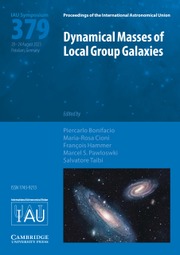No CrossRef data available.
Article contents
Detection of density variations and off-track features in stellar streams
Published online by Cambridge University Press: 30 October 2025
Abstract
Stellar streams unveil galactic histories through gravitational interactions, mergers, and tidal disruptions. To explore the complex morphology of streams, we use a ∼47 million halo main sequence stars catalogue using Gaia DR3 proper motion and photometry information, the combination of which renders the reduced proper motion parameter. This sample with reliable photometric distances reaches out to ∼21 kpc thereby probing much further out than would be possible using reliable Gaia parallaxes. Binned velocity moments on-sky pop up several known streams in the inner halo - particularly retrograde structures, due to the kinematic selection. We select and characterise the streams GD-1, Jhelum and Phlegethon. The faint signs of disequilibrium in the form of kinks and density variations in these thin streams will paint a more detailed picture of the existence and properties of the dark matter sub-haloes that perturb them and in turn, the mass distribution of our Galaxy.
Information
- Type
- Contributed Paper
- Information
- Proceedings of the International Astronomical Union , Volume 19 , Symposium S379: Dynamical Masses of Local Group Galaxies , December 2023 , pp. 3 - 9
- Copyright
- © The Author(s), 2025. Published by Cambridge University Press on behalf of International Astronomical Union


